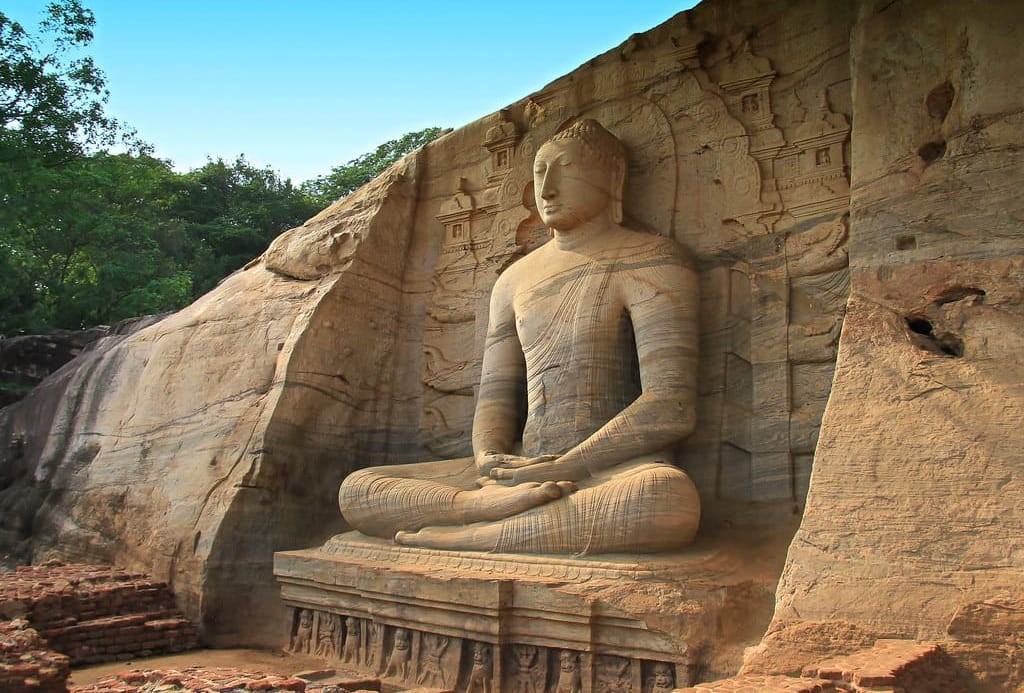Gal Viharaya

Gal Viharaya, part of the ancient city of Polonnaruwa, is a testament to the remarkable artistry and religious devotion of the Sinhalese people. This iconic site, established during the reign of King Parakramabahu I, boasts a series of beautifully crafted Buddha statues that stand as some of the finest examples of ancient rock carving in Sri Lanka.
A Masterpiece of Sinhalese Rock Carving
The Gal Viharaya complex is home to four distinct Buddha images, each intricately carved from a single slab of granite. These statues, once enshrined within separate enclosures, represent different postures of the Buddha, showcasing the extraordinary skill and dedication of the artisans of that era.
The Reclining Buddha: A Symbol of Parinirvana
One of the most striking features of Gal Viharaya is the 14-meter-long reclining Buddha, depicted entering parinirvana (nirvana-after-death). This statue is renowned for its detailed craftsmanship, particularly the delicate depression in the pillow under the Buddha's head and the intricate lotus symbols on both the pillow end and the soles of the Buddha's feet. This serene image of the Buddha has become an iconic representation of Sri Lanka's rich cultural heritage.
The Standing Buddha: A Towering Marvel
Standing at 7 meters tall, the standing Buddha is often considered the finest of the Gal Viharaya statues. Initially believed to represent Ananda, the Buddha’s disciple grieving his master’s departure for nirvana, this theory was later discredited. It is now accepted that all the images in the complex represent the Buddha. The statue’s unusual, crossed arm position and sorrowful facial expression add to its unique and captivating presence.
The Seated Buddha: A Symbol of Enlightenment
On the far left of the complex sits a magnificent seated Buddha, with an ornamental gateway (torana) above depicting four additional Buddhas. This arrangement likely represents the Five Dhyani Buddhas, symbolizing the five aspects of Buddha’s enlightenment. The natural marbling of the rock is used to exquisite effect, enhancing the statue’s visual impact.
The Small Buddha: A Hidden Gem
Nestled in a small rock cavity is the fourth Buddha statue, smaller and of slightly inferior quality compared to the others. Despite its modest size, this statue completes the quartet of Buddha images at Gal Viharaya, each contributing to the site's spiritual and artistic significance.
Visiting Gal Viharaya
Located within the UNESCO World Heritage site of Polonnaruwa, Gal Viharaya is accessible from the main city, making it a must-visit destination for history enthusiasts and spiritual seekers alike. The best time to visit is early in the morning or late in the afternoon to avoid the midday heat and to experience the statues in the soft, golden light that accentuates their features.
Practical Tips for Visitors
Entrance Fees: Included in the Polonnaruwa Archaeological Site ticket.
Dress Code: Modest attire is required, covering shoulders and knees.
Photography: Permitted but respect the sanctity of the site and avoid intrusive behavior.
Guides: Hiring a local guide can enhance your understanding of the historical and cultural context of Gal Viharaya.
Gal Viharaya stands as a remarkable testament to the artistic and spiritual heritage of Sri Lanka. Its majestic Buddha statues continue to inspire awe and reverence, drawing visitors from around the world to marvel at their beauty and significance.
